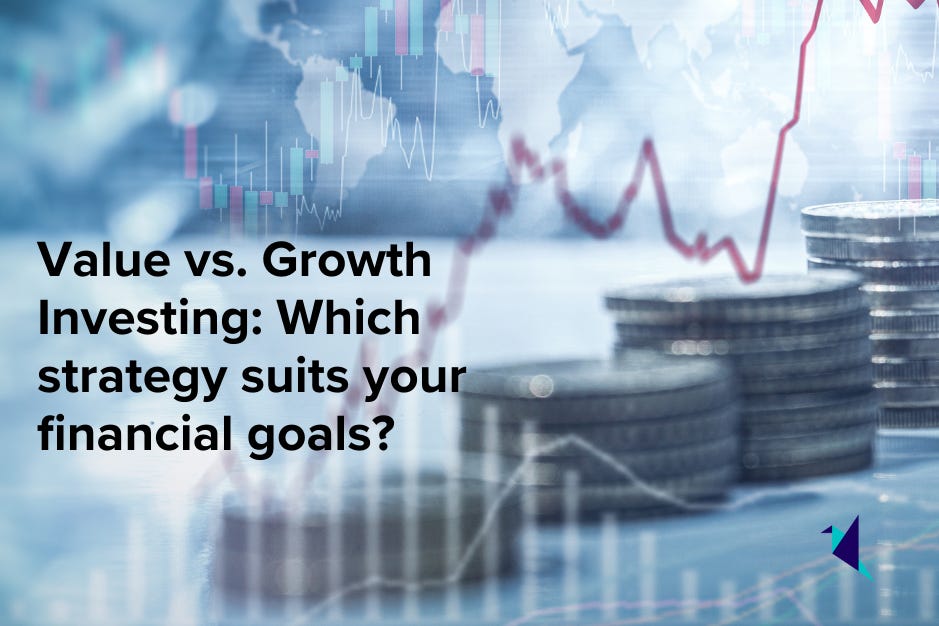Value vs. Growth Investing: Which strategy suits your financial goals? 🤔
Have you ever wondered why some investors buy 'boring' stocks, while others chase 'the next big thing'? It all boils down to two time-tested approaches: Value Investing and Growth Investing. Each strategy has its perks, quirks, and risks. But which one aligns with your financial goals?
Don't worry, we’ll break it down crisp and clear — no jargon, just straight talk. Let’s dive in!
What is value investing? 🧐
If investing were a shopping spree, value investors would be the "bargain hunters" at a clearance sale. They’re on the lookout for stocks trading for less than what they’re actually worth — think of it as buying a designer jacket at 50% off.
Value investors believe the market has undervalued certain companies, often due to market overreaction, negative news, or temporary issues. By buying these underappreciated gems, they aim to profit when the market "realizes" the company’s true value.
Key traits of value stocks 👀
Low price-to-earnings (P/E) ratio: These stocks have a lower P/E ratio compared to the industry average, which indicates they may be undervalued. It’s like buying $1 for 70 cents — you’re paying less for every dollar of earnings.
High dividend yields: Value stocks often distribute a portion of their profits as dividends, giving investors regular cash payouts. This can provide a steady income stream, especially attractive for retirees or conservative investors.
Stable, mature companies: These companies have a long track record of profitability and predictable growth. They operate in established industries with lower volatility, making them less risky during market downturns. Examples include Coca-Cola, Johnson & Johnson, and Procter & Gamble.
Strong balance sheets: Value companies often have solid financials, including low debt-to-equity ratios and consistent cash flows. This financial stability is one reason they’re considered safer investments.
Example: Imagine you’re at an art auction. A painting is selling for ₹50,000, but you know its "true worth" is ₹100,000. You buy it, and later, someone offers you ₹95,000. That’s value investing — buying something for less than it’s actually worth.
Value investor’s mantra 🔑
“Buy low, wait patiently, and let the market correct itself.”
Example: Berkshire Hathaway
Led by legendary investor Warren Buffett, Berkshire Hathaway embodies value investing. Buffett's strategy focuses on buying high-quality companies like Coca-Cola, American Express, and Bank of America when they are undervalued. By focusing on a company's "intrinsic value," he has built one of the most successful investment portfolios in history.
What is growth investing? 🚀
If value investing is like bargain hunting, growth investing is like betting on tomorrow’s trends today. Instead of focusing on "cheap stocks," growth investors chase companies that are rapidly expanding, regardless of the current price.
These are the Teslas, Amazons, and AI-driven startups of the world. Growth investors buy into businesses expected to grow revenue and profits at a faster-than-average pace, even if the stock’s price already seems high.
Key traits of growth stocks 👀
High revenue growth: Growth companies are experiencing rapid increases in sales and revenue, often at double-digit rates. This growth is usually driven by market demand, product innovation, or expansion into new markets.
Reinvestment of profits: Instead of paying dividends, growth companies reinvest earnings back into the business to fuel further growth. This allows them to scale operations, develop new products, and expand into new markets.
Innovative and disruptive: Growth companies often lead industry change, introducing new technologies or services that reshape the market. Examples include electric vehicles (EVs) like Tesla and AI-focused companies like Nvidia.
High price-to-earnings (P/E) ratio: Growth stocks tend to have higher P/E ratios since investors are willing to pay a premium for future earnings potential. While this increases the price of the stock, it reflects the market’s belief in future success.
Volatility and risk: Growth stocks are more sensitive to market sentiment and news, leading to higher price swings. Investors seeking growth must be comfortable with short-term volatility.
Example: Imagine you’re buying a baby sapling that’s growing faster than other trees. While it’s tiny now, you’re betting it’ll become a giant oak tree. Growth investing is about backing future potential, even if it’s pricey today.
Growth investor’s mantra 🔑
“Buy high, sell higher.”
Example: Amazon (AMZN)
In its early years, Amazon focused on growth at all costs, reinvesting profits to expand its infrastructure and dominate e-commerce. While the company posted little to no profits for years, its rapid revenue growth made it a darling of growth investors. Today, Amazon is one of the largest companies in the world, thanks to its growth-first approach.
Value vs. growth: Key differences 🆚
Quick takeaway: Value investing is like slow, steady cooking — it takes time but yields consistent results. Growth investing is more like a pressure cooker — intense, fast, but risky.
Final verdict: Which one wins? 🤔
Choosing between Value Investing and Growth Investing isn’t about picking a winner — it’s about picking the right strategy for your unique financial goals. Both have their strengths and weaknesses, and both can coexist in a balanced investment portfolio.
Why choose value investing?
You value stability, steady growth, and dividends.
You have a long-term investment horizon and are willing to wait for the market to "catch up."
You prefer tried-and-true companies with predictable cash flows, like Coca-Cola or Johnson & Johnson.
Why choose growth investing?
You’re chasing higher returns and willing to accept greater volatility.
You believe in the power of disruption and want to ride the next wave of AI, EVs, or new technologies.
You’re comfortable with risk and prefer capital appreciation over steady dividends.
The journey of $1000 over a decade
If you had invested $1000 in 2014 using the Value Approach, your investment would have grown steadily over the 10-year period, reaching a balance of approximately $1,835 by 2024. The value strategy focuses on stable, established companies that generate consistent returns. While the growth was gradual, it provided a sense of security with lower volatility.
On the other hand, the Growth Approach delivered significantly higher returns, with the same $1000 investment growing to an impressive $6,844 by 2024. The growth strategy emphasizes high-potential, fast-growing companies. Although this approach comes with more risk, it also offers greater reward potential. The sharp increase in certain years, such as 2018 and 2019, reflects the higher returns typically associated with growth stocks. This scenario highlights the power of compounding and how it can dramatically increase wealth over time when invested in high-growth opportunities.
What’s the ultimate strategy? 🤷♂️
The best approach is often a hybrid strategy — blending the steady reliability of value stocks with the explosive potential of growth stocks. Diversification helps reduce risk while offering you access to both consistent cash flows and the possibility of big gains.
Pro tip: Rebalance your portfolio periodically. Growth stocks may surge faster, while value stocks offer stability. Adjust your holdings based on market conditions and your financial goals.
Bottom line: If you’re looking for a financial strategy that’s "just right," think like Goldilocks. Sometimes it’s not about choosing "all value" or "all growth" — it’s about finding the perfect blend that works for you.
Disclaimer: All content provided by Winvesta India Technologies Ltd. is for informational and educational purposes only and is not meant to represent trade or investment recommendations. Remember, your capital is at risk. Terms & Conditions apply.











